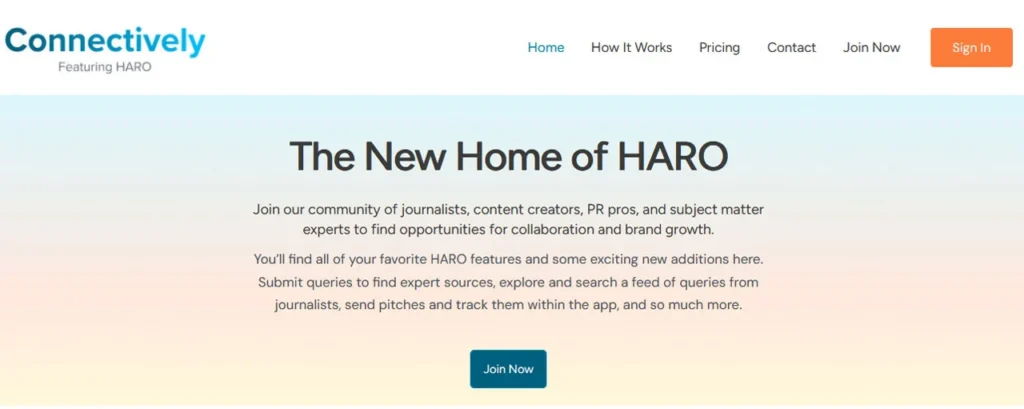In the ever-evolving world of SEO, acquiring high-quality backlinks remains a critical component of any successful strategy. One of the most effective and underutilized methods to gain authoritative backlinks is through HARO (Help A Reporter Out) link building. This comprehensive guide will walk you through the intricacies of HARO link building, helping you leverage this powerful tool to enhance your online presence and boost your SEO efforts.
1. What is HARO?
HARO, or Help A Reporter Out, is a platform that connects journalists with expert sources. Journalists and bloggers post queries looking for sources to provide insights, quotes, or information for their stories. By responding to these queries with valuable input, you can earn backlinks from high-authority websites, enhancing your SEO.

2. Why HARO Link Building is Effective
2.1 High-Quality Backlinks
HARO allows you to secure backlinks from reputable news sites, blogs, and publications. These high-quality backlinks can significantly improve your domain authority and search engine rankings.
2.2 Enhanced Brand Exposure
Responding to HARO queries not only earns you backlinks but also positions you as an authority in your industry. This increased exposure can lead to more media opportunities and brand recognition.
2.3 Targeted Traffic
Backlinks from relevant, high-traffic websites can drive targeted traffic to your site, increasing your potential for conversions and engagement.
2.4 Cost-Effective Strategy
Compared to other link-building methods, HARO is relatively cost-effective. It only requires your time and effort to respond to queries, making it accessible for businesses of all sizes.
2.5 Long-Term Benefits
Links acquired through HARO tend to be more durable and trustworthy. These links can continue to provide SEO benefits over time, as they come from reputable sources and are less likely to be removed.
3. How to Get Started with HARO?
3.1 Signing Up
Visit the HARO website and sign up as a source. You can choose from free or paid subscription plans, with paid plans offering additional features such as keyword alerts and profile promotion.

3.2 Understanding HARO Queries
HARO sends out three emails daily, each containing a list of queries from journalists and bloggers. These queries are categorized by industry, making it easier for you to find relevant opportunities.
3.3 Choosing the Right Subscription
While the free subscription provides access to all queries, paid plans offer advanced features like keyword alerts and the ability to create a profile showcasing your expertise. Consider your needs and budget when choosing a subscription plan.
4. Crafting the Perfect HARO Pitch
4.1 Be Relevant and Concise
Ensure your response directly addresses the journalist’s query. Provide concise, relevant information that demonstrates your expertise. Avoid unnecessary details and focus on the core of the query.

4.2 Provide Value
Offer unique insights, data, or quotes that add value to the journalist’s story. The more helpful and informative your response, the higher your chances of being featured.
4.3 Include a Bio
Always include a brief bio and a link to your website. This not only helps the journalist verify your credentials but also ensures you receive proper attribution if your response is used.
4.4 Proofread Your Response
Ensure your pitch is well-written and free of grammatical errors. A polished and professional response increases your chances of being featured.
4.5 Follow Submission Guidelines
Pay close attention to any specific instructions provided by the journalist. This might include word limits, formatting preferences, or additional information requirements.
5. Best Practices for HARO Success
5.1 Respond Quickly
Journalists often work on tight deadlines, so timely responses are crucial. Aim to respond within a few hours of receiving the query.

5.2 Personalize Your Pitch
Address the journalist by name and reference their publication. A personalized approach shows that you’ve done your research and are genuinely interested in contributing.
5.3 Track Your Pitches
Keep a record of your pitches and monitor which ones result in backlinks. This can help you refine your approach and identify the types of queries that yield the best results.
5.4 Build Relationships
Consistently providing valuable insights can help you build relationships with journalists. This can lead to more media opportunities and increased trust in your expertise.
5.5 Stay Consistent
Make responding to HARO queries a regular part of your routine. Consistency increases your chances of being featured and helps you stay on top of new opportunities.
6. Advanced HARO Strategies
6.1 Use Keyword Alerts
Paid HARO subscriptions offer keyword alerts, notifying you of queries that contain specific keywords relevant to your industry. This allows you to focus your efforts on the most pertinent opportunities.
6.2 Leverage Your Network
If a query isn’t directly relevant to your expertise but suits someone in your network, consider referring them. This can strengthen your professional relationships and may lead to reciprocal opportunities in the future.
6.3 Repurpose Your Responses
Turn your detailed HARO responses into blog posts, social media content, or newsletters. This maximizes the value of your efforts and helps establish your authority on multiple platforms.
6.4 Optimize for Journalists
Journalists often receive numerous responses to their queries. Make your pitch stand out by crafting a compelling subject line and providing a clear, concise answer. Highlight why your input is unique and valuable.
6.5 Follow Up
If you don’t hear back from a journalist, a polite follow-up can sometimes make the difference. However, avoid being pushy or persistent; a single follow-up email is usually sufficient.
7. Measuring the Impact of HARO Link Building

7.1 Monitor Backlinks
Use tools like Ahrefs or Moz to track the backlinks you earn from HARO. Monitor their impact on your domain authority and search engine rankings.
7.2 Analyze Traffic
Check your website analytics to see how much referral traffic comes from your HARO backlinks. Analyze the behavior of these visitors to understand the quality of traffic being driven to your site.
7.3 Assess Brand Mentions
Keep track of where and how often your brand is mentioned in the media as a result of your HARO efforts. Increased brand mentions can lead to more opportunities and enhanced reputation.
7.4 Evaluate Conversion Rates
Determine how much of the traffic from HARO backlinks converts into leads or sales. This helps you understand the ROI of your HARO efforts and refine your strategy accordingly.
7.5 Gather Feedback
Ask journalists for feedback on your responses. Constructive feedback can help you improve your pitches and increase your chances of being featured in the future.
8. Common Challenges and Solutions

8.1 High Competition
HARO queries can attract numerous responses. To stand out, ensure your pitch is well-researched, concise, and provides unique value. Highlighting your unique perspective or expertise can make a significant difference.
8.2 Lack of Responses
Not all pitches will result in backlinks. If you’re not receiving responses, review your pitches to ensure they are relevant, concise, and error-free. Consider seeking feedback from peers to improve your approach.
8.3 Time Management
Responding to HARO queries can be time-consuming. Set aside dedicated time each day to review and respond to queries. Using keyword alerts can also help you focus on the most relevant opportunities.
8.4 Maintaining Consistency
It can be challenging to respond to HARO queries amidst other responsibilities consistently. Create a schedule or set reminders to ensure you regularly check and respond to queries.
8.5 Building Relationships
Establishing relationships with journalists takes time and effort. Be patient and persistent, providing valuable insights consistently to build trust and rapport over time.
Conclusion
HARO link building is a powerful strategy for earning high-quality backlinks, increasing brand exposure, and driving targeted traffic to your website. By crafting effective pitches and following best practices, you can leverage HARO to boost your SEO efforts and establish your authority in your industry. Start incorporating HARO into your link-building strategy today, and watch your online presence grow.
